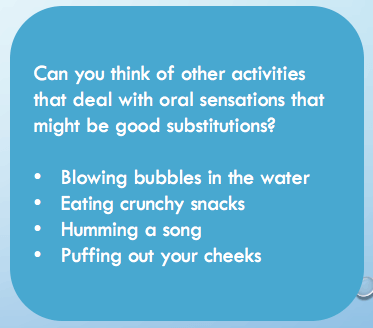With our sense of taste, we perceive:
- Sweet
- Salty
- Sour
- Bitter
- Umami (savory)

Oral Sensory System
As a result of our oral sensory system, we perceive:
- Temperature
- Texture
- Taste
And we can control our ability to :
- Chew
- Speak
- Eat and drink
Oral Sensory Dysfunction
There are some instances where someone might have problems with some part of their oral sensory system.
This would make the skills on the previous slide difficult/ impossible to do normally
They may have either heightened oral sensitivity or decreased oral sensitivity.
Heightened Oral Sensitivity
This is referring to unusually intensified oral sensations, often making textures/tastes/temperatures/chewing “too much” for a person to handle or process.
During activities involving the mouth, this may lead to:
- Choking
- Gagging
- Avoidance when placing objects/tastes (including food, eating utensils) in mouth
- Tantrums
Decreased Oral Sensitivity
This is referring to unusually desensitized oral experiences, often causing individuals to “seek out” oral textures/tastes/temperatures/chewing more than the typical person.
Seeking out oral sensations might look like:
- Eating/ preferring foods with strong tastes – drinking ocean water
- Chewing on non-edible objects- life jacket straps, snorkel mouth pieces, sand, sleeves
- Making noise with their mouths – humming, clicking, buzzing
Chewelry
Chewelry is a form of jewelry that can be worn like a necklace and can be chewed on.
They come in many different styles and provide someone who “seeks” oral sensations a way to satisfy their needs.

What can I do?
Safety is the priority. If someone is in danger attempt to stop the behavior and seek assistance.
If you see someone “seeking out” inappropriate oral sensations, try and suggest a more appropriate activity.
For example, you see someone chewing on their lifejacket straps. Do they have ”chewelry?” Or would they like to munch on a snack?


